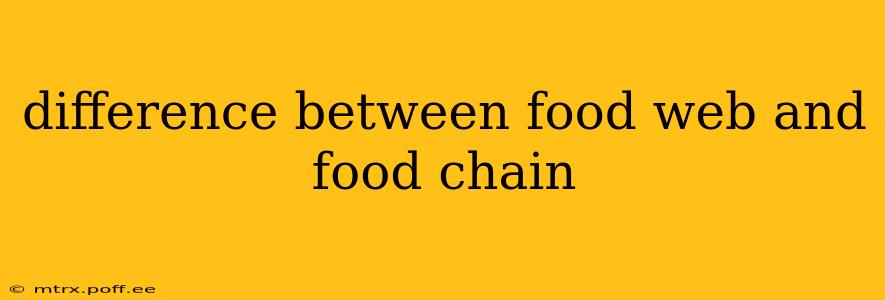Understanding the intricate relationships within an ecosystem requires grasping the concepts of food chains and food webs. While seemingly similar, they represent different levels of complexity in illustrating the flow of energy and nutrients. This article will delve into the key differences, clarifying their roles in ecological studies.
What is a Food Chain?
A food chain is a linear sequence depicting the transfer of energy and nutrients from one organism to another. It starts with a producer (usually a plant) that creates its own food through photosynthesis. This producer is then consumed by a primary consumer (herbivore), which is subsequently eaten by a secondary consumer (carnivore), and so on. This sequence typically ends with a top predator, an apex organism with few or no natural predators.
Example: Grass → Grasshopper → Frog → Snake → Hawk
This simple chain illustrates a direct pathway of energy transfer. However, nature is far more complex than this single linear progression.
What is a Food Web?
A food web is a more realistic and complex representation of the interconnected feeding relationships within an ecosystem. Unlike the linear nature of a food chain, a food web shows multiple interconnected food chains. Organisms can occupy multiple trophic levels (feeding levels) and participate in several chains simultaneously. This intricate network demonstrates the complex interactions between various species and how energy flows through the entire ecosystem.
Think of it this way: A food chain is like a single road, while a food web is like a vast highway system with multiple interconnecting roads.
What are the Key Differences Between a Food Web and a Food Chain?
The primary difference lies in their complexity and scope.
| Feature | Food Chain | Food Web |
|---|---|---|
| Structure | Linear | Interconnected and complex |
| Complexity | Simple | Complex |
| Number of Organisms | Shows a single pathway of energy flow | Shows multiple pathways and interconnectedness |
| Realism | Simplified representation of reality | More accurate representation of ecosystem dynamics |
| Organism Roles | Organisms occupy a single trophic level | Organisms can occupy multiple trophic levels |
How Do Food Chains and Food Webs Help Us Understand Ecosystems?
Both food chains and food webs are essential tools in ecology for understanding:
- Energy flow: How energy is transferred from one organism to another within an ecosystem.
- Nutrient cycling: How essential nutrients are recycled throughout the ecosystem.
- Species interactions: How different species depend on each other for survival.
- Ecosystem stability: How changes in one part of the food web can impact the entire ecosystem.
- Impact of human activities: How human interventions, such as habitat destruction or pollution, affect the food web and ecosystem health.
What are the limitations of food chains and webs?
While useful, both models have limitations:
- Simplification: They simplify complex interactions in nature. Parasites, decomposers, and the full extent of symbiotic relationships are often not completely depicted.
- Dynamic nature: Ecosystems are constantly changing, and food webs are not static. They shift with environmental changes and population fluctuations.
How are food chains and food webs related?
Food webs are essentially collections of interconnected food chains. A single food chain is a simplified component of the much larger and more complex food web. Understanding individual food chains helps to understand the broader picture of the food web.
Conclusion
In conclusion, while food chains provide a simplified overview of energy flow, food webs offer a more comprehensive and realistic depiction of the complex relationships within an ecosystem. Both are valuable tools for ecological research and understanding the interconnectedness of life on Earth.
